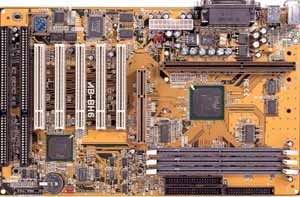Future Power - Power Series P3-500
by Anand Lal Shimpi on October 3, 1999 12:13 AM EST- Posted in
- Systems
Motherboard, CPU & Memory
 The
Power Series is built around the ABIT BH6, which
was the overclocker's motherboard to get last year. The key word there is
"was" since the release of the BH6, ABIT as well as a number of other companies
have produced successors to the BH6 offering the same features with new tweaks and
options. From a cost perspective, going with the BH6 instead of the newer BE6-II or the AOpen AX6BC Pro Gold
just meant that the overall cost of the system would be brought down by around $10 - $20.
Although there is nothing blatantly wrong with the BH6, we would have liked to see an
AOpen or an ASUS board used in place of the BH6 or, at least, ABIT's BE6, which offers
on-board Ultra ATA 66 support. However, we must admit that, although we do have high
expectations, if you look at the non-overclockable motherboards that most system builders
opt for, the BH6 is truly a blessing.
The
Power Series is built around the ABIT BH6, which
was the overclocker's motherboard to get last year. The key word there is
"was" since the release of the BH6, ABIT as well as a number of other companies
have produced successors to the BH6 offering the same features with new tweaks and
options. From a cost perspective, going with the BH6 instead of the newer BE6-II or the AOpen AX6BC Pro Gold
just meant that the overall cost of the system would be brought down by around $10 - $20.
Although there is nothing blatantly wrong with the BH6, we would have liked to see an
AOpen or an ASUS board used in place of the BH6 or, at least, ABIT's BE6, which offers
on-board Ultra ATA 66 support. However, we must admit that, although we do have high
expectations, if you look at the non-overclockable motherboards that most system builders
opt for, the BH6 is truly a blessing.
The BIOS on the BH6 was revision LG and was configured primarily using the default settings provided in the setup utility. This revision of the BIOS setup allowed for the manual assignment of IRQs to individual PCI slots, a feature first introduced into the ABIT motherboard line with the BX6 Revision 2. The number of FSB settings available in the BIOS setup pave the way for overclocking. Those settings include the following: 66/75/78/81/83/90/95/100/105/110/112/113/115/117/118/122/126/133/135/137/138/142/144/155MHz.
Future Power opted to go with the Pentium III 500 on the BH6, and from a performance perspective we know that the Pentium III 500 is still fairly competitive with the rest of the processors from Intel in the market. However, since the system was obviously designed for Windows 98, it would have made more sense for Future Power to include a cheaper, Celeron 500 on a Socket-370 to Slot-1 adapter. This would have easily brought down the overall cost of the system and the performance difference, especially under Windows 98 (which the system is preloaded with), is next to nothing in the majority of applications that you'll be running under 98.
The system was outfitted with a single 128MB SDRAM stick, with our review unit featuring memory from Crucial Technology, a division of Micron. The choice to include a single SDRAM DIMM instead of going with two 64MB DIMMs is a wise one designed to make sure that your expansion options are kept open if you do decide to upgrade the memory on the system in the future.
The performance of this combo was identical to what our standard test bed was able to accomplish in the normal suite of business/office application tests, i.e. Winstone 99, SYSMark 98. While the performance was respectable, the use of the ABIT BH6 did compromise some stability. If you've ever used an ABIT motherboard, you'll know that the stability of the board isn't bad at all. But, if you've ever used an ABIT motherboard and then upgraded to an AOpen or ASUS board, for example, (or vice versa) then you'll truly understand the definition of motherboard stability.
For most gamers and regular users, the BH6 is just fine in terms of stability. The only time this is really an issue is under high-stress conditions, such as 3D modeling, development, or other professional applications under Windows NT where signal clarity and integrity are the governing forces behind stability. Since the Power Series isn't really aimed at pleasing that market, the choice of going with the BH6 isn't a horrible one, but there is always room for improvement.










0 Comments
View All Comments